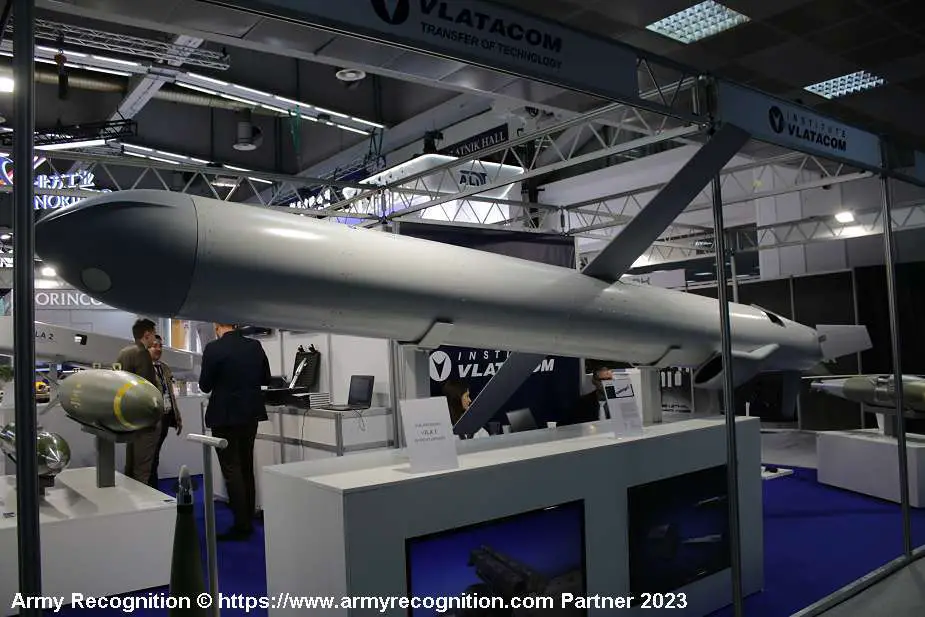The Serbian Vlatacom Institute recently presented its Vila 1 (Vlatacom Integrated Loitering Ammunition), a modular loitering munition system. Designed to offer adaptability and versatility in various military operations, its modular architecture allows for the integration of diverse guidance systems and warhead configurations, tailored to specific target categories. The warhead features Vlatacom's vAF-M17/vFI-17 fuzing system, which aims to enhance precision and target accuracy.
Follow Army Recognition on Google News at this link

The Serbian Vila 1 (Vlatacom Integrated Loitering Ammunition) could be armed with a 300kg warhead (Picture source: Army Recognition)
For guidance, the Vila 1 employs a combination of technologies. The missile follows a pre-programmed flight path to the target area, utilizing GNSS (Global Navigation Satellite System) and INS (Inertial Navigation System) technology for precise positioning. A radar altimeter further contributes to the missile's guidance. Within the target area, it utilizes an optoelectronic system and a two-way radio data link for precise guidance, complemented by artificial intelligence for autonomous target recognition, which enhances targeting capabilities.
The Vila 1 loitering munition is launched from a tube integrated into a vehicle equipped with an 8x8 configuration to ensure adaptability across diverse terrains. This launch tube can also be integrated into suitable warships, offering deployment flexibility. The missile is powered by a solid fuel booster motor for the initial launch and relies on a turbofan/turbojet engine for propulsion during the cruise phase. As its name suggests, it possesses loitering capabilities, allowing it to remain in the target area for extended periods.
The Vila 1 loitering munition has a length of 5.5 m (excluding the booster), a wingspan of 2.7 m, an operating altitude ranging from 50 m up to over 7,000 m, a cruise speed of 926 km/h (or Mach 0.75), and a warhead capacity of 300 kg, available in various types. Propulsion is achieved through a turbofan/turbojet engine, with launch initiated by a booster motor from the launching tube. The Vila 1 boasts a range of up to 300 km, including its loitering function.
Modular loitering munitions, like the Vila 1, offer tactical flexibility as these munitions can be equipped with a range of payloads and sensors, enabling them to perform multiple roles, including surveillance, electronic warfare, and direct attack missions. Some advanced loitering munitions are designed for reusability, returning to their launch area if they do not engage a target, thereby conserving resources in prolonged conflicts.
Operational efficiency is significantly enhanced by the extended loiter time of loitering munitions like the Vila 1, providing operators with additional time to identify and confirm targets compared to traditional missiles. With increasing autonomy achieved through AI and machine learning, the latest systems can independently search for, identify, and engage targets, reducing the need for human intervention and mitigating the risk of operator error.
Stealth and low noise capabilities are notable attributes of smaller versions of loitering munitions, making it challenging for enemy air defenses to detect and facilitate effective infiltration, as demonstrated by the Russian nuclear-powered Burevestnik loitering missile project.
From a strategic perspective, as shown in Ukraine, loitering munitions act as force multipliers, combining reconnaissance and strike capabilities within a single platform, optimizing resource allocation, and streamlining operations. In these scenarios, they empower smaller or less technologically advanced units to effectively target high-value assets, a concept incarnated by the Lancet drone.















